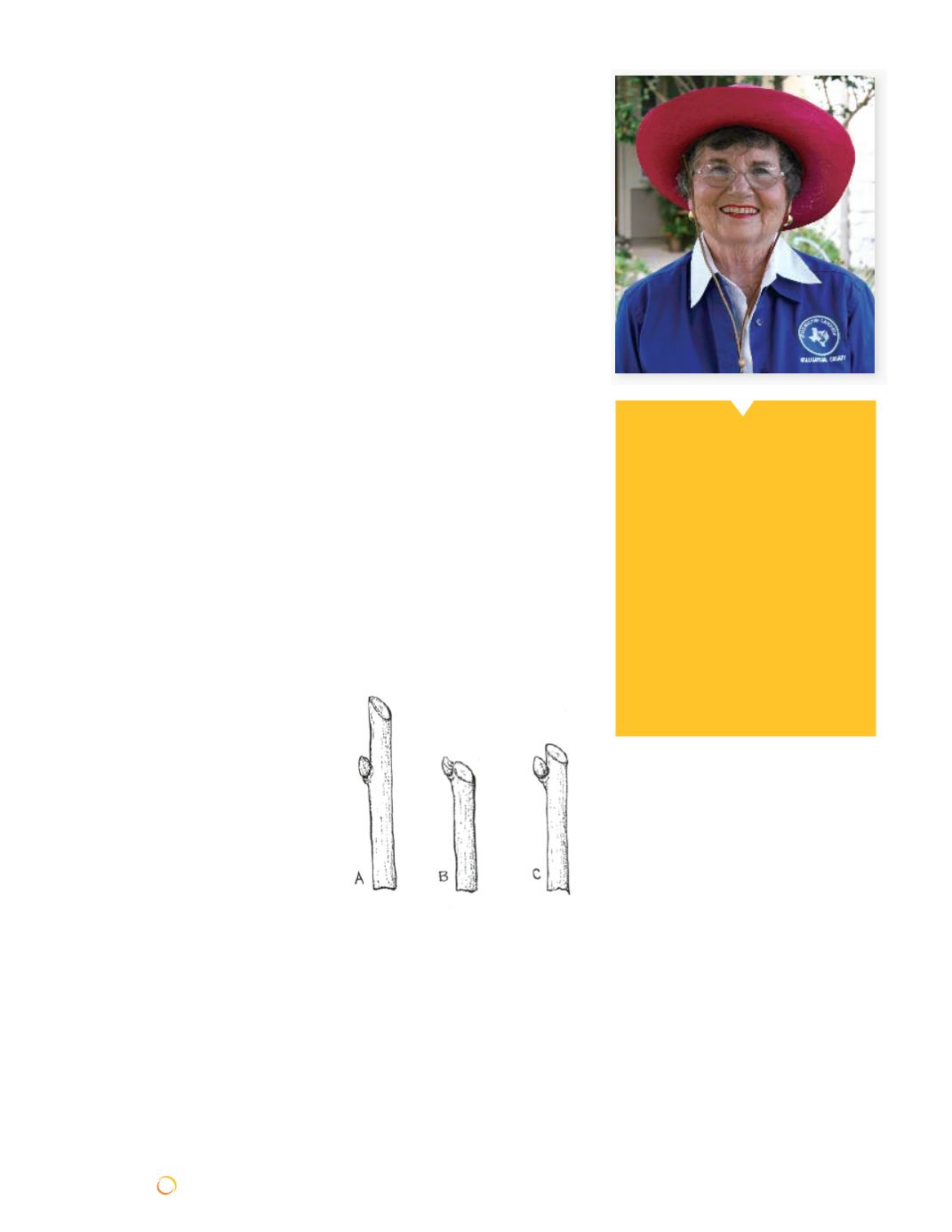
38 | SUNRAYS FEBRUARY 2015
ONLINE:
SCTXCA.ORG
Spring is coming! On average, the last
frost date for our region is March 15, so
begin trimming now (except oak trees)
so as to have early jobs completed,
giving you plenty of time to trim roses
and perennials come late February
and early March. Remember: you want
to trim before new growth, so review
information here and online, then get
your tools sharpened and ready!
A great online resource is:
-
horticulture.tamu.edu/earthkind/
landscape/proper-pruning-techniques/.
For your health and your trees’ as well,
the best practice is to hire a certified
arborist. Suggestions for trimming
bushes and perennials are as follows:
WHEN TO TRIM
Evergreen:
Best for shape when
dormant in winter
Shrubs and Trees which Bloom on
This Year’s Growth (Vitex; crape
myrtle):
January and early February
Deciduous Trees and Shrubs (non-
blooming):
Late winter
Shrubs, Roses, Fruit Trees:
Late
winter/early spring
Spring flowering trees and shrubs
(Roses):
off season or after flower
Root-Hardy Shrubs:
everything above
ground when new growth seen
Fall Blooming Perennials (Mexican
mint marigold; Copper Canyon
daisy; Mexican bush sage):
Trimming
stopped by end of July
Because trimming stimulates growth,
do not prune in late fall.
TRIM WITH PURPOSE
Trimming improves shape, bloom and
plant structure. A shaped plant will be
more attractive in your landscape and
use less water. With spacing between
plants, air circulation will reduce fungal
disease and insect infestation.
February Tips for a Beautiful
Water Wise Landscape
Winola is a Williamson County
Master Gardener, a member of
the Sun City Garden Club and a
member of the Sun City Water Wise
Task Force.
Master Gardeners and other
experienced gardeners are available
to answer questions a half hour
before Sun City Garden Club
meetings each month. The Garden
Club meets the second Wednesday
of each month beginning with
the question/answer period at
12:30 p.m.
By Winola VanArtsdalen
TRIM TO MAINTAIN
NATURAL SHAPE
First, remove old, damaged, and crossing
branches from base. Then step back and
allow the desired future growth shape
be your guide. To rejuvenate an old,
overgrown shrub, remove one-third of
the oldest, tallest branches at or slightly
above ground level before new growth
starts. It is better to gradually renew
a bush by removing a few branches
annually than to harshly prune after
many years’ growth.
UNDERSTANDING PLANT GROWTH
When you trim, energy goes to other
buds, which makes a more bushy plant.
This is true with all plants. Cut on a
slant 1/4” to 1/2” above a bud facing the
direction in which you want new growth.
(See illustration C below.) Do not leave
a long stem stub, as it will die, turning
brown and ugly.
FEBRUARY GARDENING TIPS
•Do not trim oaks now! The most
dangerous time to prune oaks is
February through June, as sap is
moving at this time and beetles are at
their most active.
•Clean up stray leaves, winter debris,
and weeds, but avoid walking on
or digging in wet soil to prevent
compaction.
•Distribute pre-emergent on turf by
February 15.
•Late winter is good time to transplant
perennials that you want to move
to other areas. Thin seedlings of
reseeding annuals and perennials to
ensure proper spacing.
•Be sure all plants are mulched 2-3”
with organic mulch to moderate
temperature, slow evaporation and
allow release of nutrients to plants.
•Before a freeze, water plants for
hydration, but do not water during
freezing temperatures.
Source: Texas A&MAgriLIFE Extension
Service
Horticulture Questions:
Contact Williamson County
AgriLIFE Extension Office at
512-943-3300


